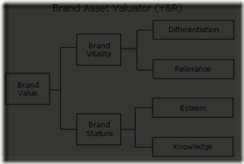Marketing fundas…
|
Three key factors to create a successful business strategy. Explanation of 3C’s Model of Ohmae |
|
The 3C’s model of Kenichi Ohmae, a famous Japanese strategy guru, stresses that a strategist should focus on three key factors for success. In the construction of any business strategy, three main players must be taken into account:
THE STRATEGIC TRIANGLE Only by integrating the three C’s (Customer, Corporate, and Competitor) in a strategic triangle, a sustained competitive advantage can exist. Ohmae refers to these key factors as the three C’s or the strategic triangle. 1: CORPORATE-BASED STRATEGIES These strategies aim to maximize the corporation’s strengths relative to the competition in the functional areas that are critical to achieve success in the industry:
This means cherry-picking operations with a high impact, so that when other operations are eliminated, functional costs will drop faster than sales revenues.
2: CUSTOMER-BASED STRATEGIES Clients are the basis of any strategy according to Ohmae. There is no doubt that a corporation’s foremost concern ought to be the interests of its customers rather than that of its stockholders and other parties. In the long run, the corporation that is genuinely interested in its customers will be interesting for its investors. Segmentation is advisable:
Changes in customer mix: 3: COMPETITOR-BASED STRATEGIES According to Kenichi Ohmae, these strategies can be constructed by looking at possible sources of differentiation in functions such as: purchasing, design, engineering, sales and servicing. Ways to do this:
|
|
Description of 4 P’s of Persuasion. Explanation. |
|
DEFINITION 4 P’S OF PERSUASION. DESCRIPTION. 4 P’s of Persuasion is a framework to formulate persuasive written messages.
The 4P’s stand for Promise, Picture, Proof, and Push:
|
|
Generating the optimal response in the market. Explanation of Marketing Mix of E. Jerome McCarthy. |
|
WHAT IS THE MARKETING MIX? DESCRIPTION The Marketing Mix model (also known as the 4 P’s) can be used by marketers as a tool to assist in defining the marketing strategy. Marketing managers use this method to attempt to generate the optimal response in the target market by blending 4 (or 5, or 7) variables in an optimal way. It is important to understand that the Marketing Mix principles are controllable variables. The Marketing Mix can be adjusted on a frequent basis to meet the changing needs of the target group and the other dynamics of the marketing environment.
The function of the Marketing Mix is to help develop a package (mix) that will not only satisfy the needs of the customers within the target markets, but simultaneously to maximize the performance of the organization. There have been many attempts to increase the number of P’s from 4 to 5P’s in the Marketing Mix model. The most frequently mentioned one being People or Personnel. Booms and Bitner have suggested a 7-Ps approach for services-oriented companies.
Book: Nirmalya Kumar – Marketing As Strategy: Understanding the CEO’s Agenda.. – |
|
Measuring Brand Value. Explanation of Brand Asset Valuator of Young & Rubicam. |
|
A supply chain practice where one or more logistic functions of a firm are outsourced. Explanation of 3rd Party Logistics (3PL). (’80) Contributed by: Eric Goh See Khai |
|
3rd Party Logistics (3PL) is the supply chain practice where one or more logistics functions of a firm are outsourced to a 3PL provider. Typical outsourced logistics functions are: inbound freight, customs and freight consolidation, public warehousing, contract warehousing, order fulfillment, distribution, and management of outbound freight to the client’s customers. On top of this, also Value Added Services can be provided, such as: repackaging, assembling and return logistics. The 3PL Provider manages and executes these particular logistics functions using its own assets and resources, on behalf of the client company. The thoughts behind this are to keep the firm competitive by keeping it lean without owning much assets, allowing it to focus on niche areas and to reduce operational costs. Third Party Logistics is also referred to as Contract Logistics. 3PL is evolving from predominately transactional-based to more strategic in nature. At the same time 3PL is gradually evolving into 4PL. A Fourth Party Logistics provider is a supply chain services provider that searches the best logistical solutions for its client, typically without using own assets and resources. Relatively new is the term 5PL or even 7PL, indicating Total Supply Chain Management Outsourcing. ORIGIN OF 3RD PARTY LOGISTICS (3PL). HISTORY In the 80s, there was increased globalization and an increased use of IT. These trends resulted in increased demands on firms and possibilities for companies to operate more competitive and lean. Some successful 3PL companies emerged, such as DHL/Exel, Kuehne + Nagel, Schenker , UPS, Panalpina, C.H. Robinson, TNT Logistics, Schneider, and NYK Logistics. USAGE OF 3RD PARTY LOGISTICS (3PL). APPLICATIONS
The application of 3PL is normally done in a number of phases:
STRENGTHS OF 3RD PARTY LOGISTICS (3PL). BENEFITS 3PL allows a firm to gain competitive advantage via:
LIMITATIONS OF 3RD PARTY LOGISTICS (3PL). DISADVANTAGES AND RISKS To implement 3PL successfully, one may need to bear in mind some possible pitfalls:
ASSUMPTIONS OF 3RD PARTY LOGISTICS (3PL). CONDITIONS It can be inferred that the firm engaging this practice is likely:
Book: Edward A Silver – Inventory Management and Production Planning and Scheduling –
Book: David Simchi-Levi – Designing and Managing the Supply Chain – |





